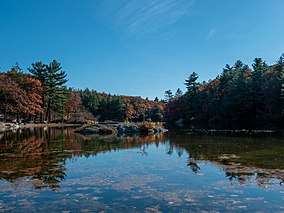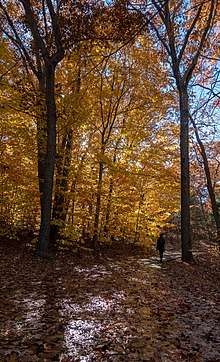Breakheart Reservation
Breakheart Reservation is a public recreation area covering 652 acres (264 ha) in the towns of Saugus and Wakefield, Massachusetts. The reservation features a hardwood forest, two freshwater lakes, a winding stretch of the Saugus River, and scenic views of Boston and rural New England from rocky hilltops. The park is managed by the Massachusetts Department of Conservation and Recreation.[3]
| Breakheart Reservation | |
|---|---|
 Breakheart's Silver Lake | |
 Location in Massachusetts | |
| Location | Saugus, Wakefield, Essex, Middlesex, Massachusetts, United States |
| Coordinates | 42°29′21″N 71°02′23″W[1] |
| Area | 652 acres (264 ha)[2] |
| Elevation | 131 ft (40 m)[1] |
| Established | 1934 |
| Operator | Massachusetts Department of Conservation and Recreation |
| Website | Breakheart Reservation |
Breakheart Reservation Parkways | |
  | |
| Location | Saugus and Wakefield, Massachusetts |
| Built | 1934 |
| Architect | Charles Eliot |
| MPS | Metropolitan Park System of Greater Boston MPS |
| NRHP reference No. | 03000748 |
| Added to NRHP | August 11, 2003 |
History
- Native Americans
Archaeological evidence shows that hunting, camping, and fishing took place along the Saugus River as far back as the Paleo-Indians and continuing through the Archaic and Woodland periods.[4]
- Colonial period
In 1666, John Gifford, the second general agent of the Saugus Iron Works, who had left the company over a dispute with its creditors, purchased 260 acres along the Saugus River from Thomas Breedon of Boston for £260. He established his own iron works on the site, which closed in 1675 due to the economic downturn caused by King Philip's War. Gifford's site later housed a sawmill (1703–1740), wire-manufacturing operation (1814–1828), a snuff-grinding mill (1837–1871), and a second sawmill (1871–1902).[4]
- The Six-Hundred Acres
In 1706, the land (known as the Six-Hundred Acres) was divided among the male settlers. During the 18th and 19th centuries, the land remained largely unchanged. Most of the land was passed down through the same families. Most landowners resided off of the property and used the land for firewood, if at all.[4]
In 1814, a fieldstone milldam was constructed downstream from the Gifford site to provide power for the Linen and Duck Manufactory Company of Boston. The mill closed after the War of 1812 due to a decline in the demand for sailcloth; however, the dam still exists.[4]
- Breakheart Hill Forest
In 1891, Benjamin Newhall Johnson, Micajah Clough, and John Bartlett of Lynn began purchasing land in the Six-Hundred Acres for use as a hunting retreat. They created Upper Pond (today's Silver Lake) and Lower Pond (today's Pearce Lake), stocked them with fish, and named their property Breakheart Hill Forest.[4] Johnson purchased a log cabin in Maine, numbered all of its parts, and brought it down to Breakheart Hill, where it was rebuilt on the shore of Lower Pond. On June 12, 1891 the retreat was officially opened. In the early 1900s, the partners increased the size of the property.[5]
- Breakheart Hill Farm
The Six-Hundred Acres was also home to Breakheart Hill Farm, an 18-acre farm. It was first owned by the Hitchings family, who sold it to Thomas Houghton for $375 in 1830. Four years later, it was sold to Artemas Edmands for $400. In 1892, Edmands' grandson sold it to the Breakheart Hill Forestry, run by Johnson and his associates, for $1.[4]
After purchasing the land, Johnson hired George Parrott to farm the land and keep out trespassers. In 1897, Parrott was succeeded by George E. Bailey. In May 1900, Bailey hired John C. Best to assist him on the property. On October 8, 1900, after a dispute, Best shot and killed Bailey. He then dismembered Bailey's body, placed the pieces in burlap bags, drove Bailey's carriage down to Floating Bridge Pond in Lynn, and dumped the bags in the pond. After a sensational trial, Best was found guilty and executed in the electric chair at Charlestown State Prison.[4]
Bailey was succeeded as caretaker of Breakheart Hill by Henry Cole. On April 12, 1901, Cole left home and was never seen again. He and his wife had an argument before he left and she believed that he had not returned because he had tired of his family situation.[6][7][8]
After Cole's disappearance, George Parker took over as caretaker and remained on the farm until his death in 1923.[4]
- State ownership
In 1934, the executors for Johnson and Clough sold the Breakheart Hill Forest to the Metropolitan District Commission for $40,000. The MDC then turned the land over to the Civilian Conservation Corps.[9] Over the course of six years, the CCC built roads and trails, planted trees, and restored the dams at Upper Pond and Lower Pond. The CCC's efforts resulted in the return of wildlife that had become rare in Breakheart, including beavers, fishers, coyotes, blue herons, and owls.[4] Breakheart was opened to the public in 1936.[5]
Activities and amenities

- Visitor center: The park is headquartered at the Christopher P. Dunne Visitor Center which opened in 2004. In addition to restrooms, educational programs and information, the center has displays and exhibits that introduce aspects of the forest's wildlife and human history.[10]
- Swimming: The beach at the north end of Pearce Lake also has a first aid station during the summer months.[11]
- Trails: Trails are available for hiking, mountain biking, and cross-country skiing.
- The park also offers fishing, orienteering, a tot lot, and a play area for dogs and their owners, Bark Place.[11]
Breakheart Parkways
On August 11, 2003, the Breakheart Reservation Parkways (officially registered as Breakheart Reservation Parkways-Metropolitan Park System of Greater Boston) were added to the National Register of Historic Places. The parkways consist of Forest Street, Pine Tops Road, Elm Road, and Hemlock Road. The parkways are under the jurisdiction of the Department of Conservation and Recreation, which also controls Lynn Fells Parkway in Melrose and Saugus. In December 2002, the Massachusetts Historical Commission voted to nominate both the Lynn Fells Parkway and the Breakheart Reservation Parkways to the Keeper of the National Register, but only the Breakheart Reservation Parkways were added to the Register that year.[12] (The Lynn Fells Parkway was separately added to the national register in 2003.) The system was designed by Charles Eliot.
See also
References
- "Breakheart Reservation". Geographic Names Information System. United States Geological Survey.
- "2012 Acreage Listing" (PDF). Department of Conservation and Recreation. April 2012. Retrieved January 19, 2014.
- "Breakheart Reservation". MassParks. Executive Office of Energy and Environmental Affairs. Retrieved August 8, 2013.
- Simcox, Alison C.; Heath, Douglas L. (2013). Breakheart Reservation. Images of America. Arcadia Publishing. ISBN 0738597791.
- "Newest and smallest state park". The Boston Daily Globe. January 10, 1936.
- "Sequel to murder of Geo. Bailey on Breakheart Hill Farm". The Boston Daily Globe. April 22, 1901.
- "No news of Henry Cole". The Boston Daily Globe. April 23, 1901.
- "A family jar caused Cole to disappear from Breakheart Hill Farm". Providence News. April 23, 1901. Retrieved July 28, 2013.
- "History". Friends of Breakheart Reservation. Archived from the original on August 1, 2013. Retrieved August 8, 2013.
- Gaffney, Mike (May 7, 2009). "Giant birthday bash for Breakheart's 75th". Wicked Local Saugus. Retrieved August 8, 2013.
- "Breakheart Reservation Map" (PDF). Friends of Breakheart Reservation. Archived from the original (PDF) on July 14, 2014. Retrieved August 8, 2013.
- "Saugus Historical Commission: Recent News". Town of Saugus. Retrieved August 8, 2013.
External links
| Wikimedia Commons has media related to Breakheart Reservation. |
- Breakheart Reservation Department of Conservation and Recreation
- Breakheart Reservation Area Map Department of Conservation and Recreation
- Friends of Breakheart Reservation
- Breakheart Reservation Map Friends of Breakheart Reservation
- Breakheart Reservation Saugus.com
